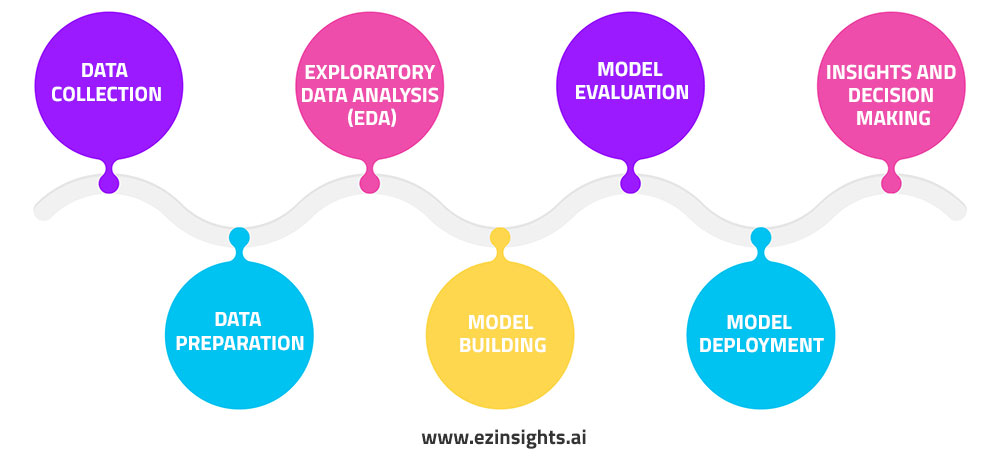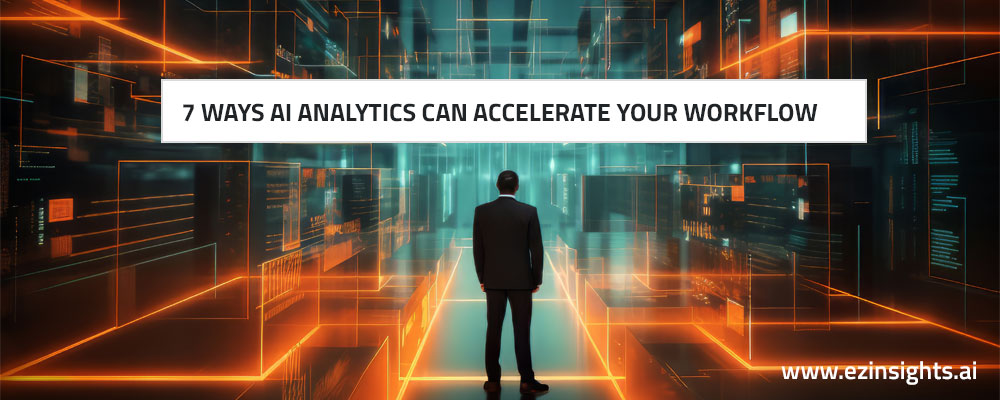In the rapidly evolving digital world of today, companies are always looking for creative ways to improve their processes and obtain a competitive advantage. Let me introduce you to AI analytics, a game-changing technology that is completely transforming how businesses function and make choices. Artificial intelligence (AI) analytics has enormous potential in a variety of fields, from streamlining procedures to improving marketing tactics. This post will examine five major ways that AI analytics can revolutionize your work process, covering its uses in video content development, digital marketing, and other areas.
Automated Insights and Decision-Making:
Businesses may now automate the process of gleaning insightful information from large databases thanks to AI analytics. Organizations can examine intricate data patterns, spot trends, and provide practical advice instantly by utilizing machine learning algorithms. This guarantees that conclusions are supported by thorough research and data, while also expediting the decision-making process.
Enhanced Personalization in Digital Marketing:
Artificial Intelligence (AI) analytics is revolutionizing tailored client experiences in the field of digital marketing. AI algorithms can segment audiences and present offers and content that are specifically relevant to them by evaluating consumer data, such as browsing habits, past purchases, and demographic data. This degree of customisation increases client loyalty and boosts engagement as well as conversions.
Optimized Content Creation for YouTube Videos:
Owing to the rapid expansion of video content on websites like YouTube, content producers are always looking for new methods to differentiate themselves from the competition. AI analytics provides creative ways to maximize the production of video content. AI algorithms may offer content creators insightful information by evaluating sentiment analysis, engagement metrics, and audience preferences. This allows content creators to customize their films for optimal impact and viewer engagement.
Predictive Maintenance and Resource Optimization:
AI analytics is essential for resource optimization and predictive maintenance in sectors like manufacturing and logistics. AI systems may anticipate possible faults before they happen by evaluating sensor data from machinery and equipment. This allows for proactive maintenance and reduces downtime. Furthermore, supply chain logistics and inventory management are two areas where AI analytics help optimize resource allocation to save money and streamline operations.
Streamlined Workflow with AI-Powered Tools:
Lastly, a multitude of tools and solutions for streamlining workflow operations across multiple functions are provided by AI analytics. Artificial intelligence-powered solutions, such as chatbots for customer support, task automation, and project management, are completely changing the way businesses run. These technologies allow teams to concentrate on high-value tasks and strategic goals by expediting regular tasks and freeing up critical time and resources.
AI Analytics Workflow

Data Collection:
Gather relevant data using APIs, web scraping, and databases. Automate with tools like BeautifulSoup, ensuring data quality for effective AI model performance.
Data Preparation:
Clean and preprocess collected data by handling missing values, normalization, and integration from diverse sources using tools like Pandas and Apache NiFi.
Exploratory Data Analysis (EDA):
Analyze data patterns through visualization and statistical methods (Matplotlib, ggplot2) to refine hypotheses iteratively for deeper insights and understanding.
Model Building:
Develop machine learning models (Scikit-learn, TensorFlow) selecting algorithms and tuning hyperparameters using cross-validation to optimize performance.
Model Evaluation:
Assess model accuracy and reliability with validation techniques (k-fold cross-validation), using metrics (accuracy, precision) and tools (confusion matrix, ROC curves) for error analysis.
Model Deployment:
Deploy models on scalable platforms (AWS SageMaker) with monitoring (Prometheus, MLflow) and maintenance for continual updates and performance checks.
Insights and Decision Making:
Present actionable insights via BI tools (Power BI), supporting strategic decisions with clear communication and a feedback loop for continuous model improvement.
How to use AI
How to use AI for Digital Marketing
AI enhances digital marketing by analyzing customer behavior, optimizing ad targeting, and personalizing content. It automates tasks like email campaigns, SEO analysis, and customer segmentation, improving ROI through predictive analytics and real-time insights. AI tools such as chatbots and recommendation engines drive engagement and conversions, revolutionizing marketing strategies.
How to use AI for YouTube Videos
AI enhances YouTube video performance by analyzing viewer preferences, optimizing titles, thumbnails, and descriptions for higher click-through rates. It automates video editing, captioning, and recommends content based on user behavior. AI-driven analytics provide insights for content strategy, audience engagement, and growth, improving video visibility and viewer retention.
Conclusion
To sum everything up, AI analytics is a game-changing technology with the ability to completely change workflows in a variety of industries. AI analytics have many different uses, ranging from tailored marketing and automated insights to predictive maintenance and optimal content development. Businesses may seize new chances for creativity, productivity, and expansion in an increasingly cutthroat market by integrating AI analytics.
FAQs
What is AI analytics and how does it accelerate workflow?
Artificial intelligence algorithms are used in AI analytics to examine massive datasets and produce insights that may be used. AI streamlines workflow by decreasing human labor, automating data processing and analysis, and delivering real-time insights for well-informed decision-making.
What industries can benefit from AI analytics in workflow optimization?
Numerous industries, including banking, healthcare, marketing, manufacturing, and more, have found extensive uses for AI analytics. Through the identification of inefficiencies, trend prediction, automation of repetitive processes, and productivity enhancement across multiple industries, it can optimize workflow.
How can businesses integrate AI analytics into their existing workflow processes?
To incorporate AI analytics into their operations, businesses must first pinpoint their problems and opportunities for development. After that, they can decide on appropriate AI platforms or tools, gather pertinent data, train AI models, and progressively put AI-driven solutions into practice. Sustained observation and improvement are necessary to guarantee AI analytics’ efficacy in workflow optimization.

Anupama Desai
President & CEO
Anupama has more than 23 years of experience as business leader and as an advocate for improving the life of the business users. Anupama has been very active in bringing business perspective in the technology enabled world. Her passion is to leverage information and data insights for better business performance by empowering people within the organization. Currently, Anupama leads Winnovation to build world class Business Intelligence application platform and her aim is to provide data insights to each and every person within an organization at lowest possible cost.

